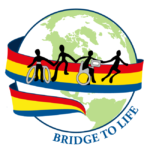Located in the San Francisco Bay area, our educational program serves students with complex communication needs associated with severe speech and physical impairments. Students attend a 180-day regular school year program between the hours of 8:30 a.m. and 2:30 p.m. The length of the school day is dependent upon individual students’ age and grade level.
Our educational program is based on the principle of providing students with severe physical and speech impairments with the supports needed to participate in age-appropriate curricular activities. We focus on supporting the language and communication development of each of our students, with emphasis on developing augmentative and alternative communication (AAC) systems for each learner.
The Bridge School educational program is designed to:
- assist students in working towards communicative competence through the use of AAC systems and strategies
- provide students access to the general education curriculum through active participation in all classroom activities
- maximize each student’s educational potential by providing access to assistive technologies for learning and literacy development
- provide long-term, ongoing, individualized support to students and their educational teams in their home school district
Two classrooms serve up to fourteen students each school year. All students have educational inclusion opportunities within an age-appropriate general education class on the shared North Elementary School campus. The weekly inclusion schedule is based on the team’s educational priorities for each student for the school year. Bridge School students are accompanied by a Bridge School staff member for all inclusion activities at North School.
For an in-depth look at the Preschool Program, visit our Course of Study online.
For an in-depth look at the Elementary Program (K-6), visit our Course of Study online.
Bridge School Students
The Bridge School’s Education Program is specifically designed for children with severe speech and physical impairments (SSPI). Although our students each possess their own uniqueness, they may share certain characteristics as well. As with all children, they may vary widely in terms of their characteristics, capabilities and learning needs.
Children with SSPI cannot produce sufficient, intelligible natural speech to meet daily communication needs, most often due to a physical condition known as cerebral palsy (CP). CP is a complex condition characterized by wide variation in motor or physical function including limitations in movement, balance, sensation, perception and communication. Children with SSPI have complex communication needs that require an intensive focus on multimodal communication across conversation partners and environments.
Children with SSPI may:
- Have difficulty controlling head and trunk posture in most positions;
- Require supports to achieve voluntary control of movement;
- Use specially adapted seating to sit comfortably;
- Sit on their own but may not stand or walk without significant support;
- Have difficulty grasping, holding or reaching for objects;
- Have to be lifted or assisted by another person to move;
- Struggle to produce a range of consistent, physical behaviors that can be easily recognized and interpreted meaningfully by even highly familiar people;
- Rely mostly on developmentally early or unconventional behaviors to communicate, such as body posture, eye gaze and vocalizations for prolonged periods of time without appropriate augmentative and alternative communication (AAC) intervention;
- Achieve self-initiated mobility using power wheelchairs and dynamic standing mobility devices;
- Develop effective communication skills through training and the use of assistive technology.
Without carefully designed instruction, intervention and supports, the ability to understand and use language may not develop in spite of a strong motivation to interact and communicate meaningfully. Even when it is unclear whether or not a child will eventually develop natural speech and make gains in motor skills, as can be the case, children with SSPI will benefit from an intensive, developmentally appropriate, accessible educational experience.
For more information please see:
Beukelman, D. R. & Mirenda, P. (2013) Augmentative and Alternative Communication. Baltimore: Paul Brookes Publishing Co.
CanChildCenter for Child Disability Research at McMaster University in Hamilton, Ontario, Canada www.canchild.ca.
Koppenhaver, D.A & Yoder, D. E. (1993). Classroom literacy instruction for children with severe speech and physical impairments (SSPI): What is and what might be. Topics in Language Disorders 13, (v 2) pages 1-15.
School Accountability Report Card (SARC)
2023-2024 SARC – published during the 2024-2025 school year [PDF, 358KB]


